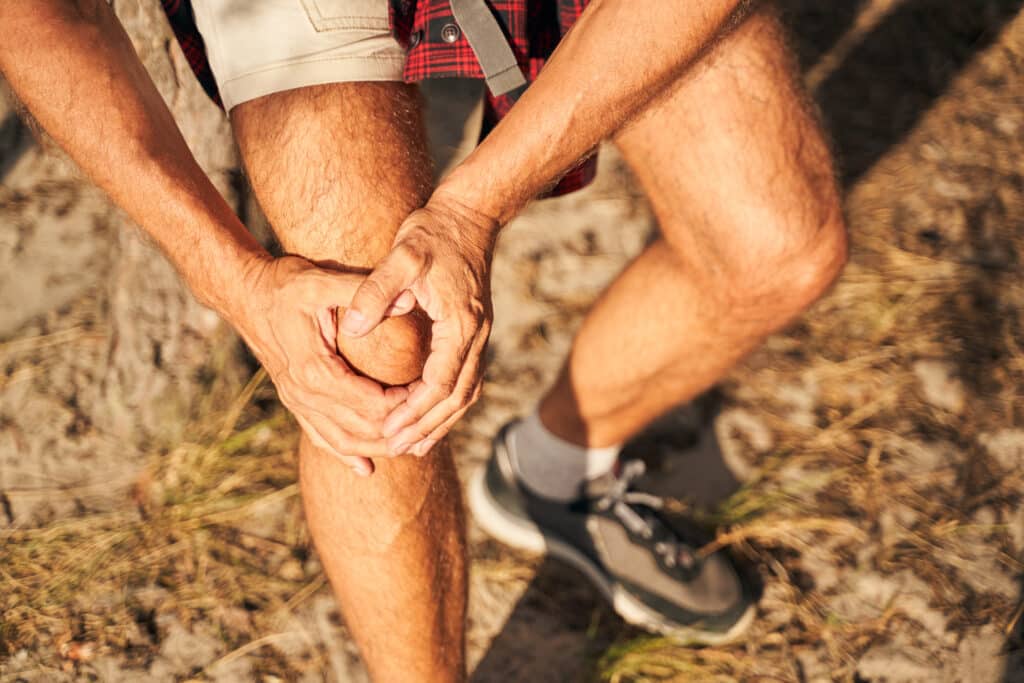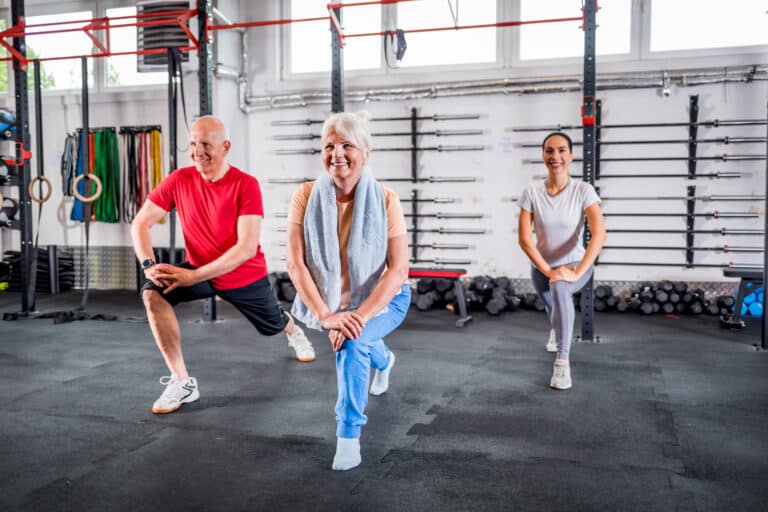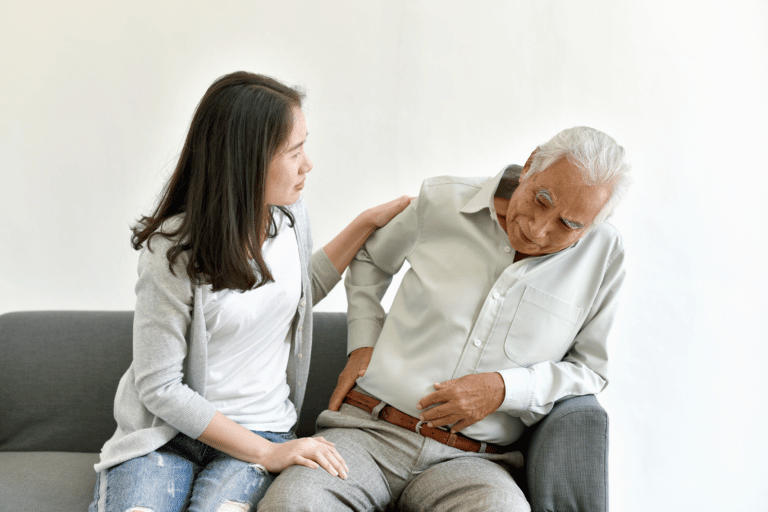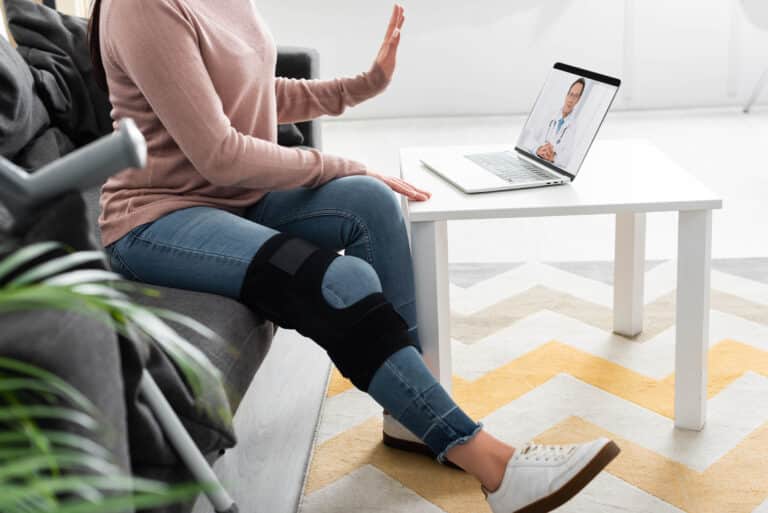Do you feel pain or stiffness in your knee when you walk, kneel, or bend? Or perhaps you’ve noticed persistent swelling around your kneecap? If so, you might have knee bursitis, a condition that affects many active adults.
Knee bursitis is an inflammatory condition of the knee that can interfere with your daily activities and affect your quality of life. As a physical therapist with plenty of experience helping older adults recover from injuries, I’ve seen first-hand the many problems knee bursitis can cause.
In this article, I will share some practical strategies, treatments, and lifestyle tips to help you better handle knee bursitis and improve your mobility and well-being before discomfort worsens.
What is Knee Bursitis?
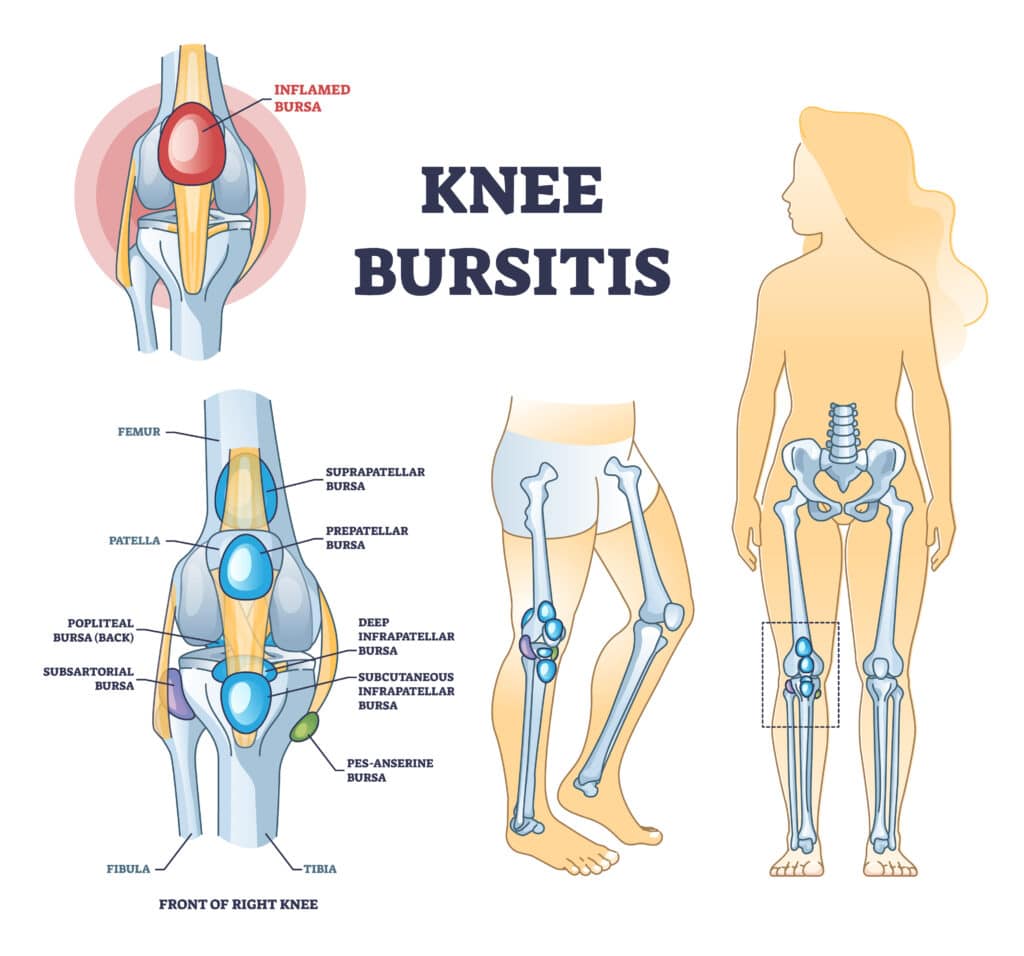
Knee bursitis, or prepatellar bursitis, is when the bursa, a small sac of fluid that cushions your knee joint, becomes inflamed and swollen. This can cause pain, stiffness, and reduced mobility in your knee.1
Knee bursitis can have many different causes, including:
- Frequent and prolonged pressure on your knee, especially from kneeling on hard surfaces.
- Overuse or strenuous activity of your knee, like running, jumping, or cycling without enough rest.
- A direct blow to your knee from a fall, accident, or collision.
- Bacterial infection of the bursa which can occur when the skin over the knee is broken or punctured.
More often than not, the patients I see have experienced some combination of these symptoms before being diagnosed with knee bursitis. While no single cause always causes this condition, these are among the most common culprits.
Now that you understand what causes knee bursitis, let’s dive into some strategies to manage it if you have been diagnosed with this all-too-common condition.
Exercises for Knee Bursitis
One of the best ways to prevent and treat knee bursitis is to exercise regularly in ways beneficial for your knee joint. Regular exercise can help increase blood flow, strength, and range of motion in your knee. It can also reduce the pressure and inflammation on the bursa, helping to reduce pain and swelling.
However, not all exercises are suitable for knee bursitis, and some can aggravate your condition. This is why I recommend choosing gentle and comfortable exercises for your knee whenever possible. Also, remember that exercise often works best alongside other treatments for bursitis, which we’ll discuss below.2
Although these exercises are ones that I recommend often in my clinical practice, they may not be well-suited for every person. We recommend you consult your doctor or physical therapist before starting a new exercise program, especially if you are experiencing new or unfamiliar symptoms.
Okay, now let’s focus on some specific exercises for knee bursitis.
Warm-Up Exercises
Before doing any strenuous exercise, it’s essential to warm up your muscles and joints. Warming up can help prevent injuries, increase blood flow, and improve flexibility in your knee.
I recommend a few minutes of warm-ups before you start your strengthening exercises, but this can vary depending on the exact workout ahead. You can do many warm-up exercises anywhere with enough space and a comfortable surface to sit or lie on.
Here are some examples of warm-up exercises that you can do for your knee bursitis routine.
Stationary bike
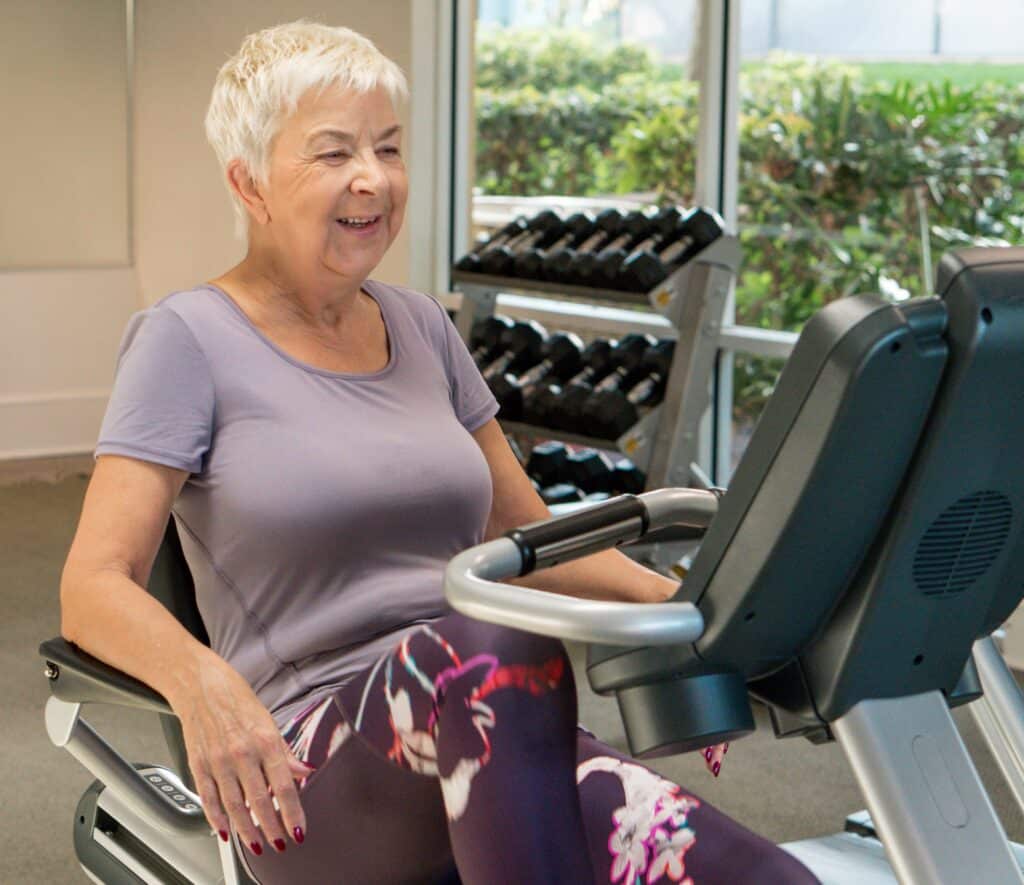
- Start by sitting on an upright or recumbent stationary bike and adjust the seat so that you can move the pedals in a full circle without pain in your affected knee.
- Pedal on the bike for 2-3 minutes using minimal or no resistance.
Heel slides
- Start by lying on your back with your legs straight.
- Slowly bend your affected knee and try to reach your heel to your bottom while sliding your heel across the floor. (It may help to place a paper plate under your heel for a carpeted floor or a washcloth on hardwood.)
- Pause when you feel a restriction, then slowly return to the start. Repeat 10-20 times on each leg separately.
Seated knee extension
- Start by sitting on a stable chair or table.
- Slowly straighten your leg as far as possible, then pause briefly and slowly return to the start.
- Repeat 10-20 times.
As you can see, these movements target the knee joint without putting you in a compromised position. This makes them ideal warm-ups for the following knee bursitis-focused movements.
Strengthening Exercises
After you warm up your muscles and joints, you can try some strengthening exercises to improve the stability and durability of your knee joint.
I typically recommend 3-5 strengthening exercises after you finish your warm-up exercises. Still, you can increase in intensity as you become stronger. You can do strengthening exercises at home or the gym. Just remember to listen to your body and take things slow to avoid causing more knee discomfort.
Here are two of the best strengthening exercises that I typically teach my patients for knee bursitis
Squats with Band
- With an elastic exercise band around your lower thighs, stand with your feet shoulder-width apart and your arms extended in front of you.
- Slowly bend your knees and lower your hips toward the floor. Keep your back straight and your chest up. With the band, it is only necessary to squat to a depth where you feel your hip muscles engage.
- Pause briefly at the bottom, then push through your heels and stand up. Repeat ten times. You can place your hands on the back of a chair for added support.
High Knee March
This exercise challenges balance and strength at the hips to support the knees.
- Begin standing tall with your arms bent at ninety degree, palms down.
- Carefully raise one knee as if you are trying to touch your palm, then gently set your foot back down
- Repeat with the other leg, focusing on a slow lift and lowering motion.
- Repeat ten or more repetitions on each leg.
It’s important to remember that while doing these exercises, you may not be able to bend your knee as deeply as you could before. To accommodate this, bend as far as you can without pain, then pause briefly before returning to the starting position.
Targeted Stretching for Knee Bursitis
Stretching is also essential as a general measure to keep knee bursitis at bay. Targeted stretches can help improve the range of motion at your knee joint, which can become especially limited if you have knee bursitis.
For best results, I typically recommend 2-3 moderately uncomfortable but not painful stretches, targeting the areas in need. Choosing stretches that are easy to perform throughout your day is best so you can do them when you have short breaks at work or between tasks. When done correctly, stretching feels good. Many patients look forward to stretching more than any other therapy treatment.
Here are some examples of stretching exercises that you can do for knee bursitis:
Chair-Assisted Quad Stretch
- Start standing in front of a chair, seat facing forward on your left side. A chair with a padded seat is ideal for extra cushion.
- Place your knee on the chair seat, using your hand on the backrest for balance support.
- Step forward with your right foot and lean toward your right leg until you feel a stretch in your left thigh. Try not to arch your back as you lean.
- Hold this position for 15-30 seconds, then switch to the other leg.
Standing Hamstring Stretch
- Start by standing before a chair or step, then raise your leg and place your heel on the chair or step.
- Keeping your leg and your back straight, slowly bend forward at your hip to stretch your hamstring.
- Hold this position for 15-30 seconds; Repeat 2-3 times.
Stretching looks different for everyone, so I always educate my patients to listen to their bodies and focus on how the stretch feels before going deeper. Remember, your main goal is to relax your knee here, so keep it gentle if you can, and if you experience pain, consider talking to your PT for a better stretching protocol for you.
Medical Treatments for Knee Bursitis
Sometimes, conservative treatment like physical therapy isn’t enough to address knee bursitis. In this case, you may need medical intervention to reduce pain and inflammation in your knee.
This doesn’t mean you shouldn’t try staying active during your recovery. Medical treatments can help speed up your recovery and prevent complications alongside things like exercise, making them an excellent complement to physical therapy in many cases.
Medications
One of the simplest and most common medical treatments for knee bursitis is medications to reduce pain and inflammation in your knee bursa.
Two medication varieties can be used for knee bursitis: over-the-counter (OTC) and prescription. You can buy OTC medications without a doctor’s prescription, such as ibuprofen or naproxen. Prescription medications are those that you need a doctor’s prescription to buy, such as corticosteroids or antibiotics.
I typically encourage my patients to use OTC medications only if they need to perform daily activities and exercise. However, when it comes to prescribed medications, you’ll always want to follow the instructions given to you by your doctor or pharmacist for safety.
Medications have side effects and can lead to dependency, so it’s essential to keep in touch with your doctor about your medications throughout your recovery. For most older adult patients, less medication is usually better if you can still participate in physical therapy and stay active.
Injections
Another medical treatment that can be used for knee bursitis involves injecting a substance into your knee bursa that can help relieve pain and inflammation. Injections can be more effective than medications for some older adults, especially if symptoms of bursitis are severe or persistent.
Two primary types of injections are used to treat knee bursitis.
- Corticosteroid injections can provide rapid and long-lasting relief of inflammation in the knee bursa. These injections can be used a few times yearly, depending on your symptoms and response to treatment.
- Local anesthetic injections can provide temporary relief of pain in the knee bursa. You can receive these injections as needed, depending on your symptoms and tolerance for activity.
While I typically don’t recommend injections to my patients with knee bursitis, they can be beneficial if you’re experiencing a high degree of pain or cannot exercise to improve your knee health. Keep an open conversation with your doctor and physical therapist throughout your recovery for the best results.
Surgery
As with many orthopedic conditions, the last resort for treating knee bursitis is surgery. Surgery can be an option for chronic or recurrent knee bursitis that does not respond to other treatments, such as exercises, medications, or injections.
Surgery for knee bursitis involves removing or draining the inflamed bursa from the knee joint. Two types of surgery can be performed for knee bursitis: arthroscopy and bursectomy.
Arthroscopy is a minimally invasive procedure that uses a small camera and instruments to access the bursa through tiny incisions. Bursectomy is a more invasive procedure that uses a larger incision to expose and remove the bursa.
Surgery is rarely needed for knee bursitis, so I encourage my patients to exhaust all other treatment options (exercise, manual therapy, medications, and injections) before opting for surgery.
Lifestyle Tips for Knee Bursitis Treatment & Prevention
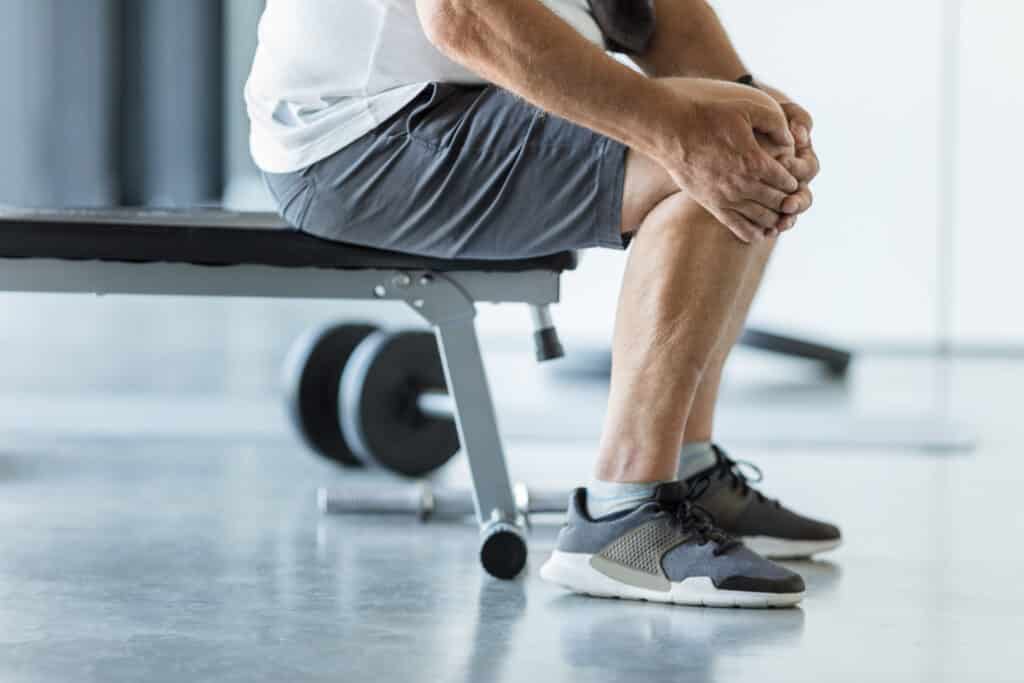
Besides exercises and medical treatments, there are plenty of lifestyle changes that you can make to manage knee bursitis better. Lifestyle changes can help reduce the risk factors and triggers of knee bursitis for many older adults, making recovery easier and promoting prevention.
Here are a few lifestyle tips I typically share with my patients to take better care of their knee health and recover from problems such as knee bursitis faster.
Relative Rest and Ice
One of the simplest and most effective lifestyle tips for knee bursitis is “relative” resting and icing your affected knee. Relative rest means staying as active as possible while avoiding activities that irritate your knee, and icing can help ease pain and inflammation in the acute phase of knee bursitis.3
It’s best to avoid or limit any activities that worsen your symptoms. You can add an ice pack to your knee a few times daily to help manage pain without medication.
You may have heard of the acronym RICE, for ‘rest, ice, compression and elevation.’ Compression can also be used to manage some conditions, and elevation is often helpful for the lower body, especially immediately after injury. Talk to your doctor about the benefits of these techniques and which might be right for you.
Weight Management
Another strategy that can help with knee bursitis is maintaining a healthy weight. Weight management can help reduce the stress and pressure on your knee joint, which can make recovery from common joint conditions easier.
Here are some tips I often share with my patients on how to maintain a healthy weight:
- Eat healthy foods that provide the nutrients and energy you need for your daily activities. It’s best to include foods from all the food groups, such as fruits, vegetables, grains, and your favorite high-protein foods. I also recommend limiting foods high in calories, fat, and sugar, such as processed foods, sweets, or fast foods.
- Eat enough food to satisfy your hunger, but only what you need. In other words, being a little hungry rather than overly full is better. Using smaller plates, bowls, or cups to control your portion sizes can be helpful.
- Consult a nutritionist who can help you plan a personalized diet that suits your needs and preferences. A nutritionist can also advise you on how to make healthy food choices, read food labels, and prepare healthy meals.
Footwear and Protective Pads
Another tip many patients benefit from is using appropriate footwear and pads to protect their knees from further injury or irritation. The right equipment can help cushion and support your knee joint, preventing or improving knee bursitis.
Footwear can significantly affect how your body interacts with the ground. For example, extra cushioning in your shoe can reduce ground reactive force or positively (or negatively) impact knee alignment. Every patient’s needs will differ, and no two cases of bursitis are identical. For this reason, I recommend scheduling a consultation with your physical therapist to ensure your footwear is best suited for your needs.
I recommend wearing footwear that balances providing good support and meeting your style preferences. In some cases, you might benefit from custom orthotics for your shoes that provide more support for your knee joint.
Regarding protective pads, I often recommend simple cushions that can be used during kneeling activities, such as gardening or manual labor. A layer of support between your knee and the ground can make a big difference in limiting pain and irritation when you have knee bursitis or preventing knee bursitis in the first place.
Key Takeaways
- Knee bursitis is the inflammation of one or more small sacs of fluid (called bursae) that cushion and lubricate your knee joint. It can cause pain, swelling, stiffness, and limited movement in the knee area.
- Knee bursitis can be caused by overuse, injury, infection, or arthritis. Some risk factors for knee bursitis include age, occupation, sports, obesity, or previous knee injuries.
- Knee bursitis can be prevented and treated with practical exercises that warm up, strengthen, and stretch the muscles around the knee. These exercises can help improve blood flow, flexibility, strength, and range of motion in the knee area. They can also reduce the pressure and inflammation on the bursa, the leading cause of pain and swelling.
- Knee bursitis can also be treated with medical interventions that reduce pain and inflammation in the bursa, such as medications and injections. These treatments can help relieve severe or chronic symptoms that do not respond to exercise. They can also help speed up recovery and help with participation in treatments like physical therapy.
- Knee bursitis can be managed with lifestyle changes such as relative rest, maintaining a healthy weight, and wearing appropriate footwear. These changes can help reduce the risk factors and triggers of knee bursitis.
References
- Rishor-Olney CR, Pozun A. Prepatellar Bursitis. [Updated 2022 Sep 6]. In: StatPearls [Internet]. Treasure Island (FL): StatPearls Publishing; 2023 Jan-.
- Butcher, J. D., Salzman, K. L., & Lillegard, W. A. (1996). Lower extremity bursitis. American family physician, 53(7), 2317–2324.
- Aaron, D. L., Patel, A., Kayiaros, S., & Calfee, R. (2011). Four common types of bursitis: diagnosis and management. The Journal of the American Academy of Orthopaedic Surgeons, 19(6), 359–367. https://doi.org/10.5435/00124635-201106000-00006

